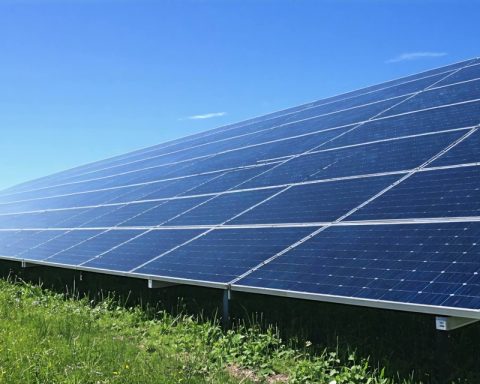- Arkansas receives nearly $200 million in green energy funding, previously halted, now revitalized under the Biden administration.
- The U.S. Environmental Protection Agency supports transformative environmental initiatives in the state.
- Metroplan’s Climate Pollution Reduction Grant, valued at $100 million, aims to reduce pollution and enhance urban green infrastructure in Central Arkansas.
- The Solar for All program, with $93 million from Hope Enterprise Corporation, focuses on providing solar energy to low-income families in Arkansas.
- These initiatives stem from the Inflation Reduction Act, advocating national environmental accountability and innovation.
- Court rulings in Rhode Island and Washington D.C. were crucial in releasing these funds, ending their bureaucratic stasis.
- Despite political challenges, leaders are enthusiastic about the potential for significant environmental progress in the state.
- This marks a shift towards a sustainable, eco-friendly future, driven by judicial support and federal commitment.
Arkansas is buzzing with fresh promise as nearly $200 million in green energy funding, previously halted during the Trump administration, flows back into the state. The U.S. Environmental Protection Agency, clearing a path for transformative environmental initiatives, has finally thawed these crucial funds.
Central Arkansas, along with its suburban and rural neighbors, is set to see transformative green infrastructure courtesy of Metroplan’s Climate Pollution Reduction Grant. This financial lifeline, amounting to a substantial $100 million, targets pollution with precision, weaving green solutions into the very fabric of the state’s urban landscape.
Meanwhile, Hope Enterprise Corporation drives change with its Solar for All program, armed with over $93 million. This initiative empowers low-income families with solar energy, providing not just economic relief but a sustainable future, cutting carbon emissions while slashing energy costs.
These projects, born from the Biden administration’s Inflation Reduction Act, embody a national shift toward environmental accountability and innovation. The legislation, a landmark in its own right, has turned the tide for states like Arkansas, promising a surge in eco-friendly development that aligns with global shifts towards sustainable energy.
Before this revival, the funding languished in bureaucratic stasis, halted by executive orders demanding comprehensive reviews of climate-related expenses. The intervention of federal judges in Rhode Island and Washington D.C. became pivotal, mandating the release of funds and ushering in a new chapter of environmental progress.
Today, the keystones of this green revolution are poised for action. Leaders within Metroplan and Hope Enterprise Corporation express enthusiasm over the reactivation of funds, seeing it as a chance to pioneer change. However, the specter of political maneuvering persists, as recent rhetoric by prominent figures highlights the fragile, often contentious path green initiatives must navigate.
The broader takeaway echoes a truth resonating beyond the borders of Arkansas: climate action cannot wait. With judicial support and federal commitment, hope simmers anew in the South, promising that with each panel installed and each plan enacted, a brighter, cleaner future draws closer.
In the evolving saga of environmental funding, Arkansas emerges as a testament to resilience, a state ready to embrace the winds of change and forge ahead into a sustainable future.
How Arkansas Is Pioneering a Green Transformation with Revitalized Funding
The Potential Impact of Revitalized Green Funding in Arkansas
With the reactivation of nearly $200 million in green energy funding in Arkansas, several critical environmental and economic landscapes are poised for transformation. This funding boost, which was previously stalled, signals a renewed commitment to sustainable development, powered largely by the U.S. Environmental Protection Agency’s initiatives and the Biden administration’s Inflation Reduction Act.
How-To Steps & Life Hacks
1. Reduce Energy Costs with Solar Power: Homeowners can leverage solar panel installations to significantly cut electricity bills. Consider state incentives and rebates to minimize upfront costs.
2. Participate in Local Environmental Initiatives: Engage with programs like Solar for All, which aims to make solar energy accessible to low-income families.
3. Adopt Sustainable Practices: Simple changes, such as reducing water usage and opting for energy-efficient appliances, can help contribute to statewide green goals.
Real-World Use Cases
– Metroplan’s Climate Pollution Reduction Grant directly targets urban pollution, preparing Central Arkansas for a greener future with improved air quality and environmentally friendly urban planning.
– Hope Enterprise Corporation’s Solar for All Program is a notable example of how renewable energy can alleviate financial burdens on low-income households while contributing to carbon reduction.
Market Forecasts & Industry Trends
Arkansas stands at the forefront of a green revolution that’s expected to spur economic growth via job creation in renewable energy sectors. The global green energy market is projected to grow, and states harnessing these innovations will likely see an uptick in investment and technological development.
Reviews & Comparisons
Arkansas’s approach to environmental reform through funding initiatives places it alongside states like California and New York, which are renowned for their sustainable energy programs. The allocation and use of these funds could serve as a model for other states grappling with similar environmental challenges.
Features, Specs & Pricing
The funding allocations target both pollution reduction and solar energy access:
– Metroplan’s Grant — $100 million for green infrastructure and pollution control.
– Hope Enterprise’s Solar Initiative — Over $93 million to provide solar solutions to low-income areas.
Controversies & Limitations
Political challenges remain a concern, with potential opposition from policy-makers wary of the economic impacts of environmental regulations. Additionally, the implementation pace needs acceleration to meet growing climate action deadlines.
Security & Sustainability
Investments in renewable energy bolster Arkansas’s energy security by reducing dependency on nonrenewable resources, fostering resilience against energy market fluctuations.
Insights & Predictions
Long-term, the green transformation is likely to drive technological advancements, job creation, and environmental improvements, reinforcing Arkansas’s standing as a leader in sustainable development.
Tutorials & Compatibility
– Installing Solar Panels: Consider space, sunlight exposure, and energy needs when installing solar panels; professional assessments can optimize efficiency.
– Energy Efficiency Audits: Conduct audits to identify areas for energy savings at home or in businesses.
Pros & Cons Overview
Pros:
– Economic growth through job creation
– Enhanced energy security
– Improved public health through reduced pollution
Cons:
– Initial high costs for infrastructure development
– Political resistance can delay projects
Pressing Questions
How will this funding impact local communities?
The expected decrease in pollution and energy costs will improve public health and economic conditions, particularly for underserved communities.
What can residents do to support these initiatives?
Participate in local policymaking and advocate for sustainable practices at community events and town halls.
Actionable Recommendations
– Stay Informed: Attend community meetings about green initiatives and funding allocations to understand their impacts.
– Utilize State Programs: Explore local government and non-profit programs that promote energy efficiency improvements.
– Reduce Carbon Footprint: Implement small lifestyle changes, such as using public transport or installing energy-efficient lighting.
By embracing these green initiatives, Arkansas exemplifies how proactive environmental planning can lead to a sustainable, economically viable future. For more information on Arkansas’s environmental initiatives, visit Arkansas.gov.









